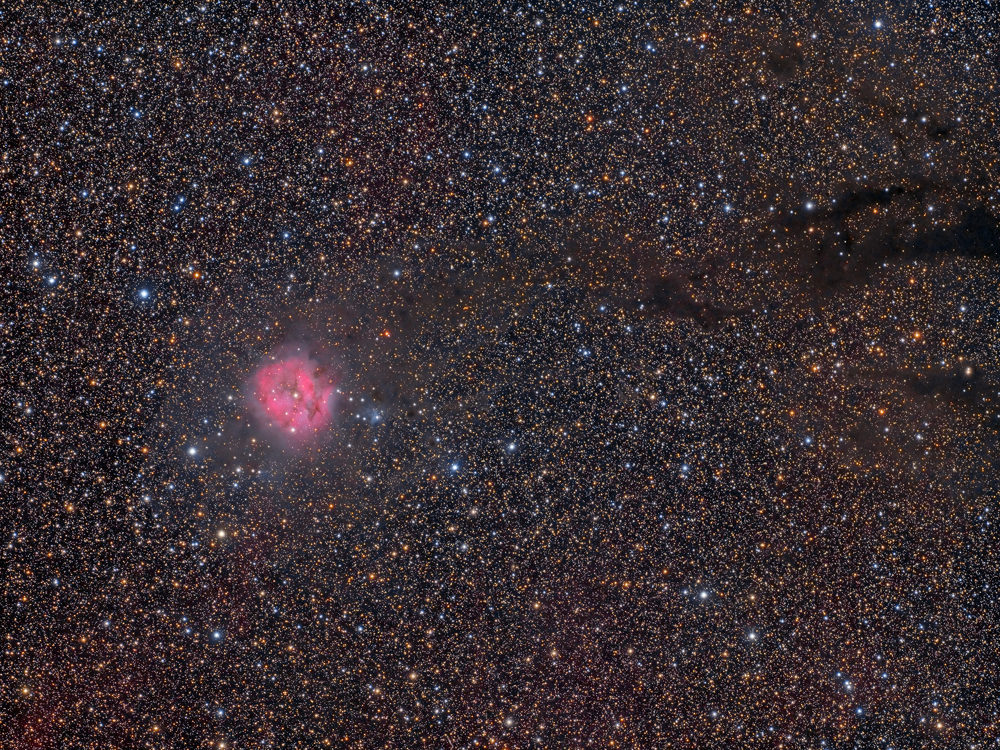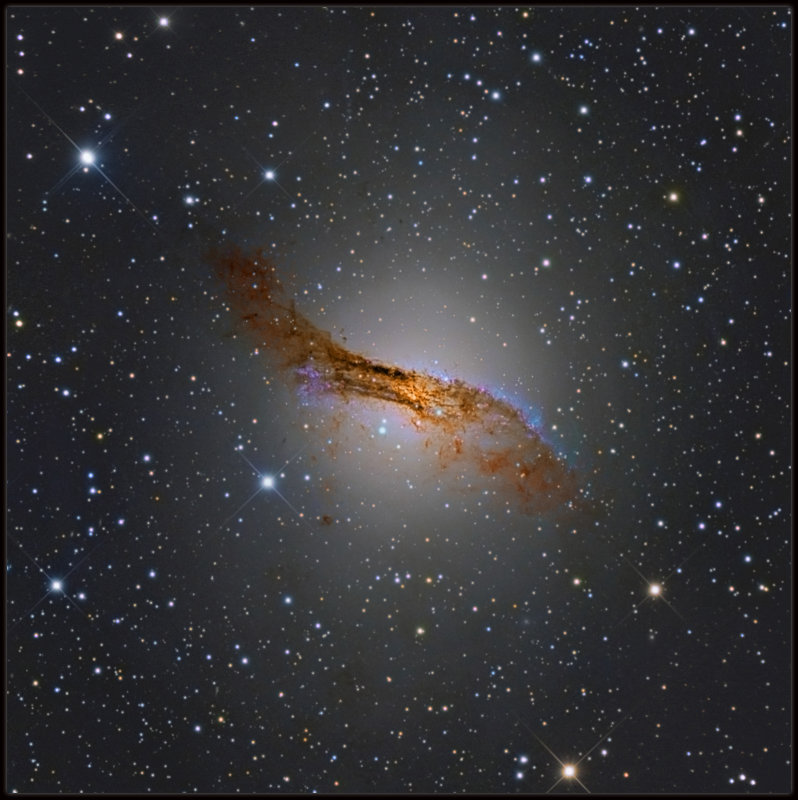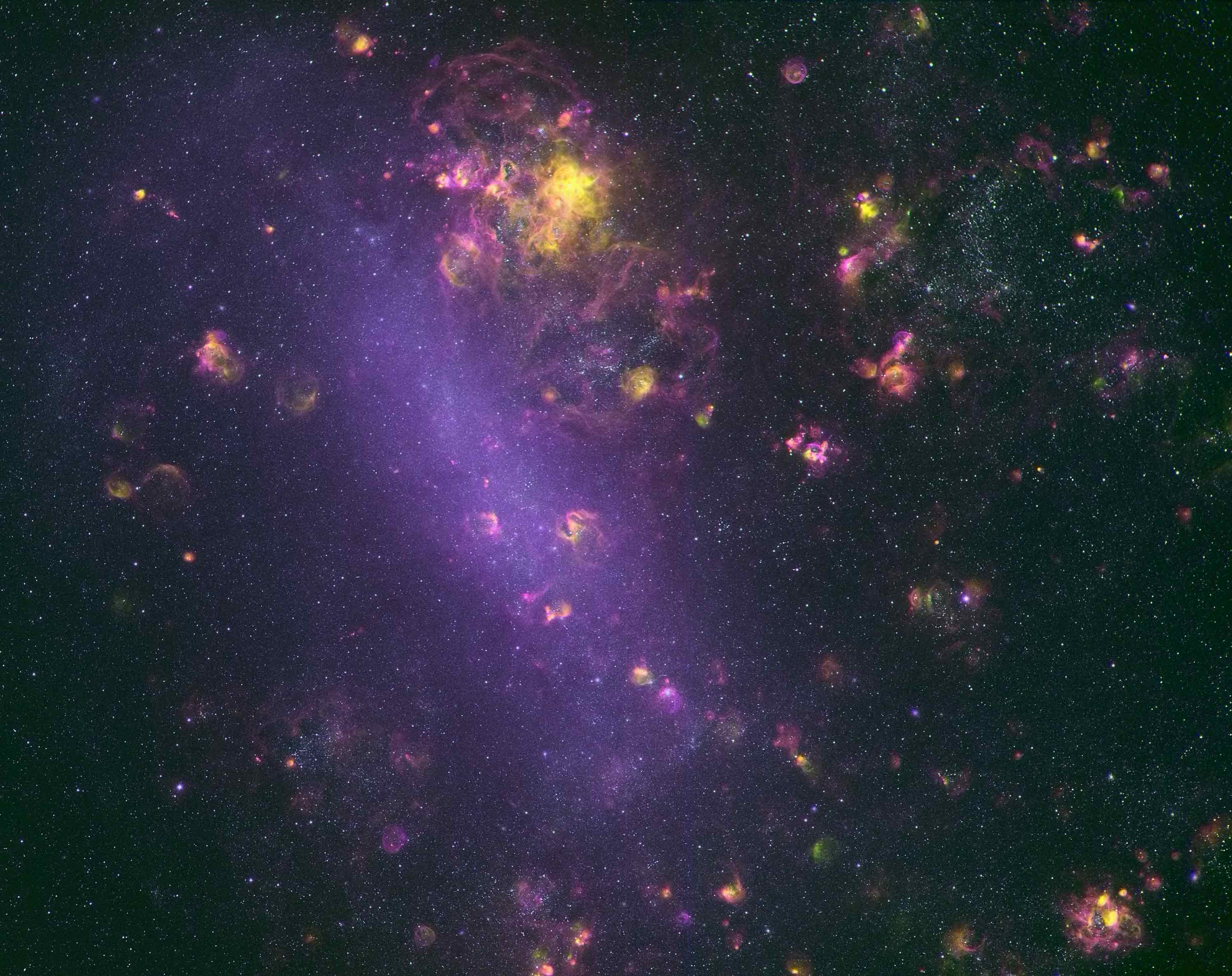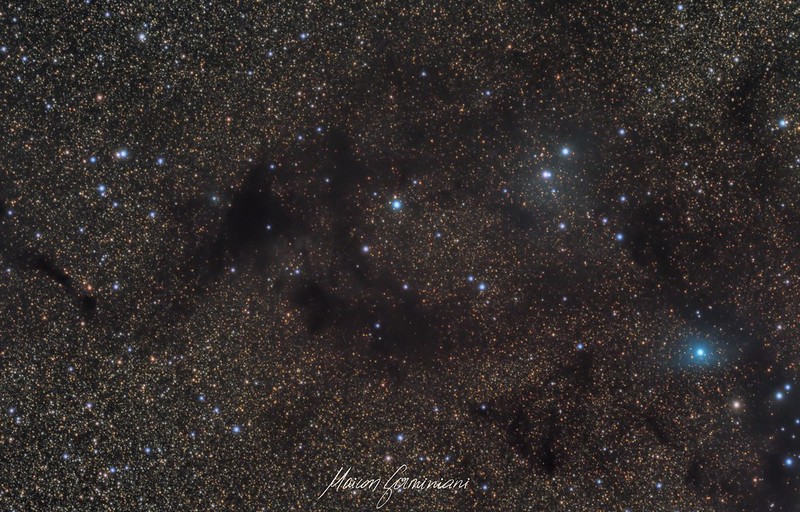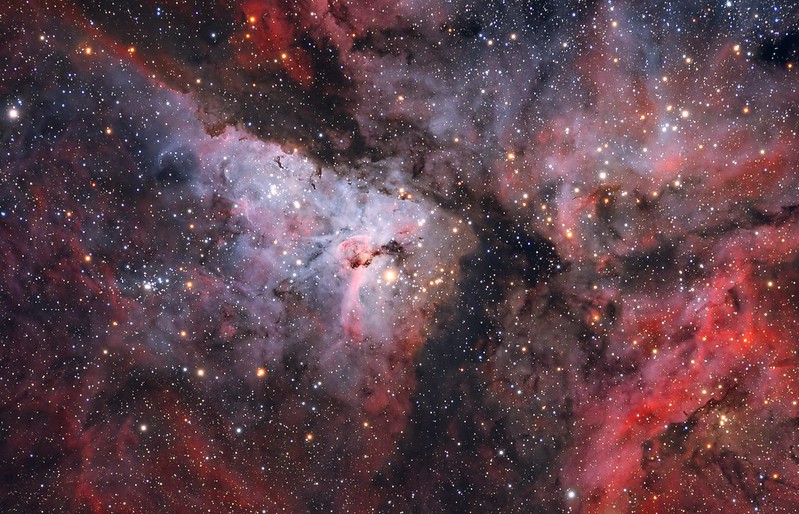Page 1 of 5
Submission: 2018 October
Posted: Mon Oct 01, 2018 1:51 pm
by bystander
__________________________________________________________________________________________________
Please post your images here.
Please see
this thread before posting images; posting images demonstrates your agreement with
the possible uses for your image.
If hotlinking to an image, please ensure it is under 400K.
Hotlinks to images over 400K slow down the thread too much and will be disabled.
Thank you!
_________________________________________________________________________________________________
<- Previous submissions
Re: Submission: 2018 October
Posted: Mon Oct 01, 2018 3:07 pm
by markh@tds.net
Cats Eye Nebula NGC 6543
Copyright: Mark Hanson
Explanation Via APOD:
The Cat's Eye Nebula (NGC 6543) is one of the best known planetary nebulae in the sky. Its more familiar outlines are seen in the brighter central region of the nebula in this impressive wide-angle view. But the composite image combines many short and long exposures to also reveal an extremely faint outer halo. At an estimated distance of 3,000 light-years, the faint outer halo is over 5 light-years across. Planetary nebulae have long been appreciated as a final phase in the life of a sun-like star. More recently, some planetary nebulae are found to have halos like this one, likely formed of material shrugged off during earlier episodes in the star's evolution. While the planetary nebula phase is thought to last for around 10,000 years, astronomers estimate the age of the outer filamentary portions of this halo to be 50,000 to 90,000 years. Visible on the left, some 50 million light-years beyond the watchful planetary nebula, lies spiral galaxy NGC 6552.
Full version can be found here:
https://www.hansonastronomy.com/cats-eye-nebula-ngc
Telescope: Planewave 24" f6.7 on a Planewave HD Mount Camera: SBIG 16803
Taken at Stellar Winds Observatory, a/k/a Stan Watson Observatory in Animas, NM.
Exposure: L,R,G,B,03 300,270,270,270,1380 For full frame. O3, HA, RGB for the core. 10-60 sec images.
Thanks,
Mark Hanson
Re: Submission: 2018 October
Posted: Mon Oct 01, 2018 3:51 pm
by tommy_h
Collinder 399 - The Coathanger
http://www.distant-lights.at/cr399-2018_08_10.htm
Copyright: Thomas Henne
Re: Submission: 2018 October
Posted: Mon Oct 01, 2018 7:41 pm
by MaPa
Cocoon with tail
www.astromarcin.pl
Copyright: Marcin Paciorek
Re: Submission: 2018 October
Posted: Tue Oct 02, 2018 9:29 am
by tango33
Hello,
For larger versions please see here:
http://www.pbase.com/tango33/new_images
Thanks,
Kfir Simon
NGC 5128:
NGC 6188:
Re: Submission: 2018 October
Posted: Tue Oct 02, 2018 4:18 pm
by mikiclinic
LMC :narrowbandimage
This image was taken with remote obsevatory in Australia from Japan.
Exposure Time AOS(100/100/100min)
http://miki-hosp.or.jp/BIND/
Copyright: Nobuhiko MIki
Re: Submission: 2018 October
Posted: Tue Oct 02, 2018 4:42 pm
by SpookyAstro
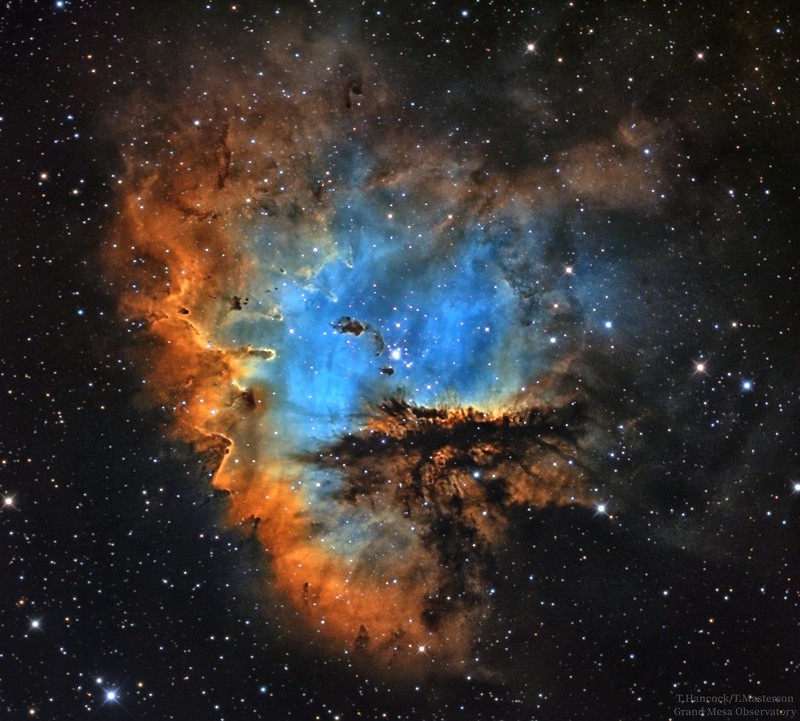 Pacman Nebula NGC 281 in Narrowband
Pacman Nebula NGC 281 in Narrowband by
Transient Astronomer, on Flickr
Image Credit and Copyright Grand Mesa Observatory, Terry Hancock, Tom Masterson
Re: Submission: 2018 October
Posted: Tue Oct 02, 2018 6:41 pm
by jose
Hola a todos os dejo esta galaxia, M 31, espero que os guste;
estos son los datos:
M 31
TOMAS:
R: Light:300segundos-17
Light:100segundos-17
Light: 50segundos-17
Light: 25segundos-17
total:2 horas 14 mihutos 35segundos
G:
Light:300segundos-17
Light:100segundos-17
Light: 50segundos-17
Light: 25segundos-17
total:2 horas 14 mihutos 35segundos
B:
Light:300segundos-17
Light:100segundos-17
Light: 50segundos-17
Light: 25segundos-17
total:2 horas 14 mihutos 35segundos
L:
Light:300segundos-17
Light:100segundos-17
Light:100segundos-17
LLight: 50segundos-17
Light: 25segundos-17
total:2 horas 14 mihutos 35segundos
Calibradas con DARK,BIAS Y FLATS
TEMPERATURA: -10 GRADOS
TUBO: FSQ 106 ED
CCD: SBIG ST-8300M
MONTURA: CGEM
CCD guiar: QHY5 II
LUGAR: LAS INVIERNAS (GUADALAJARA)
saludos
jose
[/quote]
Re: Submission: 2018 October
Posted: Tue Oct 02, 2018 10:48 pm
by barretosmed
Moon 100% ILLUMINATED
Best access details:
https://www.astrobin.com/full/369097/0/?nc=user
The Moon is usually seen in subtle shades of gray or yellow
The different colors are recognized to correspond to real differences in the chemical composition of the lunar surface.
The blue tones reveal areas rich in ilmenite, which contains iron, titanium and oxygen, mainly titanium, while the orange and purple colors show relatively poor titanium and iron regions.
Technique: "false color"
Processing and capture:
Sharpcap, AS3 !, Registax 6, Photoshop, Lightrron, Fitswork4
Equipments
Esprit 150mm triplet
1600mc
Filter L
9/22/2018
Sao Paulo-SP-Brazil
Copyright: Fernando Oliveira de Menezes
Re: Submission: 2018 October
Posted: Wed Oct 03, 2018 9:35 am
by Jean-Baptiste Auroux
NGC7293 Helix Nebula - SHO
Full version :
https://cdn.astrobin.com/thumbs/Xe7Ez3c ... hqkGbg.png
Setup : TSA102 f/6- AZEQ6 - CCD AtikOne6 (-10°)
SHO filters 6 nm
13 august 2018 (Corsica - France)
Ha : 13 x 600s bin1
OIII : 10 x 300s bin2
SII : 10 x 300s bin2
Copyright: Jean-Baptiste Auroux
Re: Submission: 2018 October
Posted: Wed Oct 03, 2018 8:32 pm
by sixburg
M17 SHO Modified Hubble
So many hues...
RCOS 14.5"
SBIG 16803
Astrodon
Paramount ME I
Very low in the sky from Deep Sky West (Lat 34 --peaks at 38.5 degrees elevation. Also occurs during the NA Monsoon so it took 2 seasons on this low priority target grabbing and hour here and there and shooting near full moon.
Ha = 16x1800" bin 1x1
Oiii = 21x1800" bin 1x1
Sii = 14x1800" bin 1x1
Integration: 25.5 hours
Avg. Moon phase: 49.05%
Re: Submission: 2018 October
Posted: Thu Oct 04, 2018 2:17 pm
by ccoop974
Deep Dumbbell
http://www.pbase.com/image/168184872
Copyright: Steve R Cooper
Bi-color M 27 in Ha and OIII (HOO) with RGB stars
SBIG STL 16803 camera and 27.5" PlaneWave CDK 700 telescope with Astrodon Gen 2 LRGB and Narrow band filter set.
36 X 5 min each RGB subs for star color, 36 X 10 min subs for Ha, and 24 X 10 min OIII. bin 1X1
Great Basin Observatory, Great Basin National Park Nevada
Re: Submission: 2018 October
Posted: Thu Oct 04, 2018 3:52 pm
by jerry10137
Pelican Region in BiColor
Copyrights: Jerry Gardner
FULL SIZE Render #1
FULL SIZE Render #2
Today I show you my most recent image. It is a narrowband Bi-Color representation of the Pelican region. I chose this as a target because I’ve always been fascinated with the strong structure in this area. It can also feel very 3D and displays a great amount of definition. This particular area lies in the constellation Cygnus and is a part of a larger nebula complex known as the North American Nebula.
Skywatcher Esprit 80
Paramount MX+
Starlight Xpress Trius SX694
Baader Filters
Hope you enjoy!
Re: Submission: 2018 October
Posted: Thu Oct 04, 2018 6:51 pm
by Maicon Germiniani
Re: Submission: 2018 October
Posted: Thu Oct 04, 2018 6:52 pm
by Maicon Germiniani
Re: Submission: 2018 October
Posted: Thu Oct 04, 2018 6:52 pm
by Maicon Germiniani
[img3]
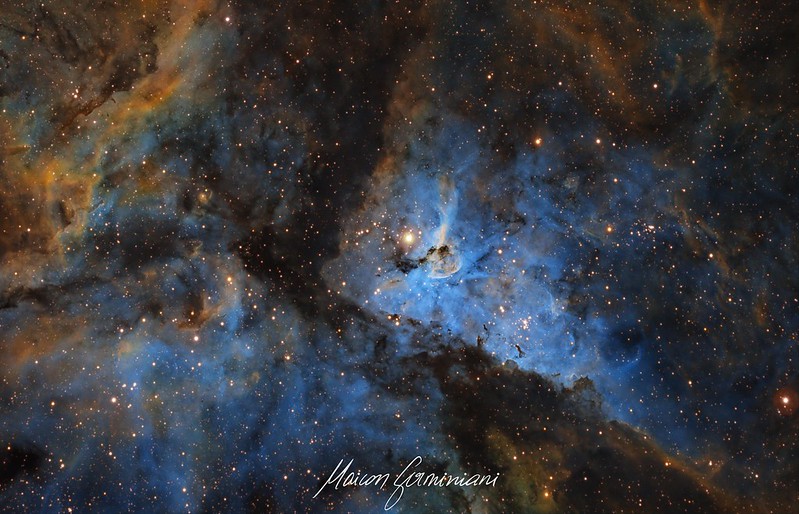 Eta Carinae
Eta Carinae by
maicon germiniani, no Flickr[/img3]
Re: Submission: 2018 October
Posted: Thu Oct 04, 2018 6:53 pm
by Maicon Germiniani
Re: Submission: 2018 October
Posted: Thu Oct 04, 2018 7:02 pm
by Maicon Germiniani
Re: Submission: 2018 October
Posted: Thu Oct 04, 2018 8:25 pm
by Riccardofiuco
Description: NCG 6888, about 5,000 light years from Earth, is also known as Crescent Nebula and is an emission nebula in the constellation Cygnus. This image was obtained using H Alpha and OIII narrowband shooting data, using the Cannistra Technique to obtain synthetic green. It shows the emissions of hydrogen and oxygen atoms, giving the image an intense red color and an interesting cyan blue mist. The tools I used are a Skywatcher 250/1000 f4; an EQ6 Mod Rowan Astronomy and a Moravian G2 8300. I processed the photo with Pixinsight 1.8
Re: Submission: 2018 October
Posted: Thu Oct 04, 2018 11:38 pm
by alfas
Fire in the sky
Milky Way rising in the Southern Hemisphere, Brazil.
http://www.instagram.com/rafadefavari
Copyright: Rafael Defavari
Re: Submission: 2018 October
Posted: Fri Oct 05, 2018 1:06 pm
by nvc123
Central part of NGC 281, a Luminance, Bi-color picture
https://www.astrobin.com/users/nvcchr1/
Copyright: Niels V. Christensen
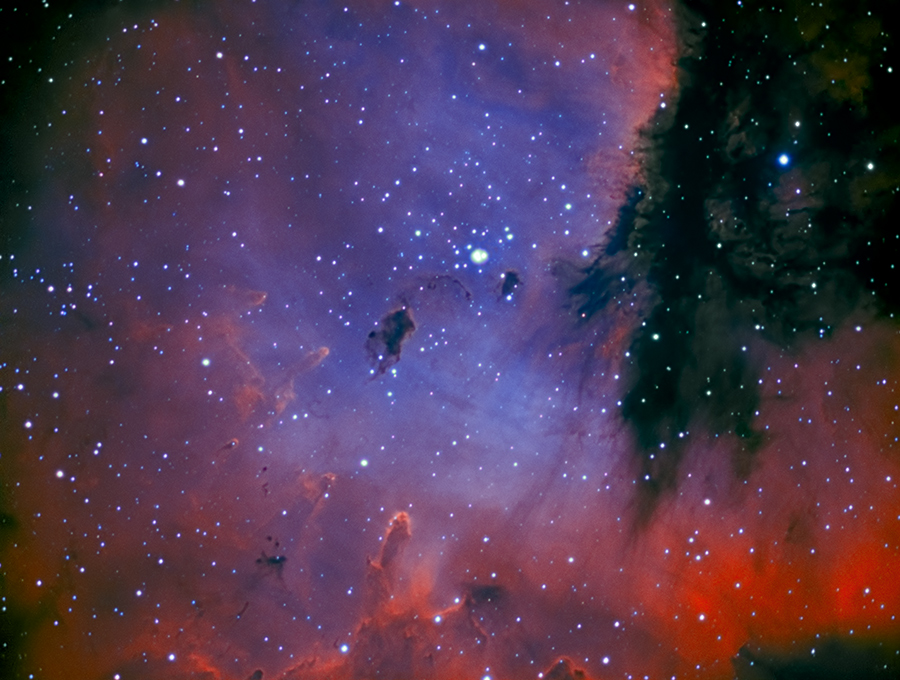
Larger picture? Please check this astrobin link, thanks,
https://astrob.in/369977/0/
Re: Submission: 2018 October
Posted: Sun Oct 07, 2018 6:13 pm
by astroligu
Rolando Ligustri wrote: continues the travelof Comet 21P (G-Z) in the midst of numerous deep sky objects. here it is above the open cluster M50
link for high res,
https://www.astrobin.com/full/370479/0/
Pleiades with extra dust
Posted: Sun Oct 07, 2018 10:59 pm
by mhultstrom
Six hour exposure of the pleiades from using a Takahashi 106mm FSQ at iTelescope's observatory at Mayhill in New Mexico, USA.
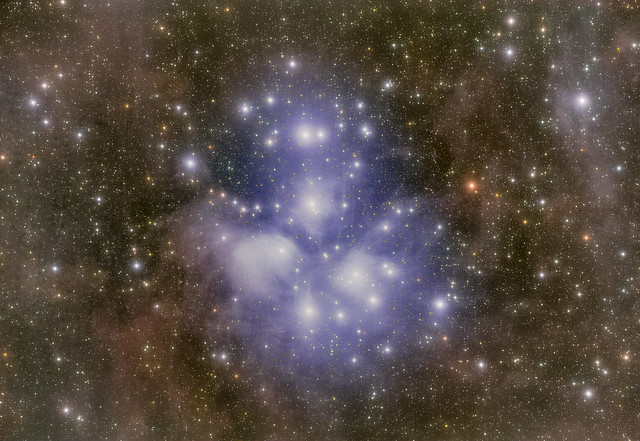 pleiadesLRGB
pleiadesLRGB by
Michael Hultström, on Flickr
Thanks for your consideration,
Michael
Re: Submission: 2018 October
Posted: Mon Oct 08, 2018 3:21 am
by behyar
Re: Submission: 2018 October
Posted: Mon Oct 08, 2018 11:32 am
by Riccardofiuco
NGC 6960, the
Veil Nebula, is a diffuse nebula located in the northern constellation Cygnus, the Swan.
It constitutes the visible parts of the Cygnus Loop, a supernova remnant in Cygnus. It is located at an approximate distance of 1,470 light years from Earth. The Veil Nebula has three main parts: the Eastern Veil, the Western Veil, and Fleming’s Triangle (Pickering’s Triangle).
H: 5 hours
OIII: 5 hours
Newton 10'' + moravian 8300
Pixinsight 1.8

